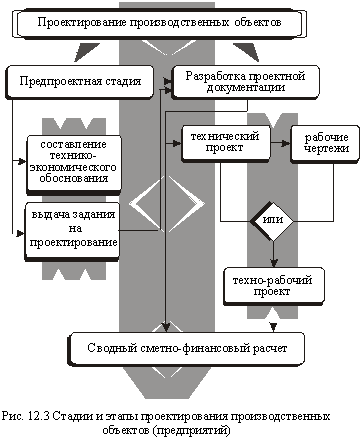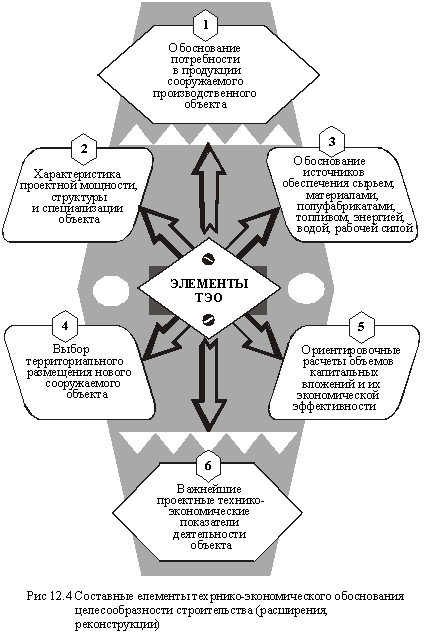home
 Economy Economy
 Business Economics - Pokropivny SF Business Economics - Pokropivny SF
|
Business Economics - Pokropivny SF
12.4 Reproduction and development of infrastructure
The formation, reproduction and development of industrial and infrastructure projects carried out in the course of capital construction, which is considered as a specific element of the enterprise infrastructure. Capital construction - is the creation of new, reconstruction, expansion, technical re-equipment of production facilities and industrukturnyh enterprise.
For major project include:
- construction of buildings and objects of industrial and non-industrial (social) purpose;
- installation of production and non-production equipment, and other means of labor and social activities;
- design and development and other preparatory work related to the construction of new and reconstruction of functioning of objects of industrial and social facilities;
- major repairs and rehabilitation of buildings and facilities for production and social facilities.
Planning for capital construction
Planning for capital construction of industrial and social facilities has certain features. The basis of the plan of capital construction of production facilities up calc Ety commissioning of production facilities, fixed assets and estimated cost of construction (reconstruction, expansion) of the respective objects. The main purpose and the end result of capital construction - commissioning of new capacities. Planning of its volumes at the enterprise is carried out in the following sequence.
- Refines the calculations of balance of production capacities of the company on the appropriate range of products. For this purpose, shall be checked: the existence of production capacity at the beginning of the planning period; estimates of their use; terms of development of the design capacity of objects previously enacted.
- Evaluated the possibility of increase production capacities by organizational and technical measures, technical re-equipment and reconstruction.
- Determined necessary volumes of commissioning of new production capacity by expanding the existing industrial facilities or new construction. They are calculated as the difference between the planned increase in the volume of the corresponding production and maximum possible increase capacity at existing production facilities due to their technical re-equipment and reconstruction.
The capital construction planning is important to determine not only the input volumes of production facilities, but also the costs associated with them. This is necessary in order to justify the economic feasibility of the construction (expansion, reconstruction), choose the best option of the capital investments in a timely manner to pay for the construction and installation works, acquisition of equipment, and so on. N. For this purpose, determine the estimated cost of the work, which actually and will cost the construction of a particular object.
The estimated cost of construction - it is expressed in monetary regulations (design) the cost of construction and installation works; purchase of equipment, tools, equipment; for design and survey work; cover other costs associated with the construction. All costs budgeted cost of construction and installation works, divided into:
- direct costs (basic wage of construction workers, the cost of building materials, components, structures, construction machines and mechanisms operating costs);
- overhead costs (maintenance costs and construction management);
- planned savings (normative profit construction companies, is the percentage of the sum of direct and overhead costs).
Tasks input of fixed assets are determined as the difference between the estimated cost of construction of facilities put into operation in the planning period, and the costs, not the cost of creating a capital stock.
Specification of tasks plan of capital construction and bring these jobs to the performers by means of the title lists of construction projects. The title list - a planning document which sets start and end dates of construction (expansion, reconstruction) of facilities, their capacity, the total cost of the construction, the construction and installation work, the annual amount of the commissioning of fixed assets, called contractors and design organizations, as well as equipment suppliers.
This scheme is carried out and planning of capital construction of social facilities. Its principal feature here is the account of their so-called capacity (number of seats in the dining room, a kindergarten, the number of daily visits to outpatient clinics, etc...)
Design objects
The initial stage of capital construction is its design. The project as a final result of the design process - a set of documents that justified the technical possibility and economic feasibility of construction (reconstruction) of a particular object. The design process is carried out, as a rule, the specialized design organizations. It covers two successive stages: 1) the collection and preparation of the necessary materials for the design; 2) direct the development of projects and estimates of calculations (Fig. 12.3).

At the first stage the feasibility study (FS) of the need for and feasibility of construction (expansion, reconstruction) of the corresponding object. Typical contents of the feasibility study is shown in Figure 12.4.
Based on the approved feasibility study of the customer together with the project organization is the task of designing the technical project that has all the necessary for the design of information, in particular: indicators of production efficiency (activity) and capital investment requirements for the use of scientific and technological and organizational progress, etc. .

The second stage - a direct projection. Depending on the size and complexity of the object, the design phase may be performed in one or two stages. For large and complex objects the design process includes two stages: 1) the development of the technical project; 2) the development of working drawings.
The composition of the technical project consists of several sections, the most important of which are: the economic part of the master plan and transport, construction of the technological part, the organization of the construction work, construction documents. Technical project together with the consolidated financial estimates to be approved by the customer. After that it becomes the basis for the financing of construction (expansion, reconstruction) of the object, ordering equipment and the development of working drawings. For the production of working drawings directly carried out construction and installation works.
For objects, construction of which is carried out according to standard designs, or for small and technically simple design of objects is carried out in a single step - through the development of techno-working project, that is a technical project with working drawings.
Methods for carrying out construction and installation work
Capital construction (expansion, reconstruction) of objects of any purpose can be done in two ways: by contract, and economic. Contracting construction - it works constantly operating in the construction and assembly organizations (contractors) under contract. In accordance with the works contract the contractor undertakes to carry out their own construction of the facility for the project in compliance with the building regulations. The customer must provide the contractor the construction site, the approved design and estimate documentation, to ensure timely funding for the construction and delivery of technological equipment, as well as the completed facility to accept and fully settle with the contractor for the work performed by the latter.
To perform the individual systems work, the contractor has the right to involve other specialized organizations subcontracted. However, the responsibility to the customer for quality and timely execution of all works shall be the primary (general) contractor.
Economic method of construction means the full range of works by the developer (businesses, organizations) on their own. In this case, the enterprise (organization) -zastroyschik acts as construction manager and executor of construction and installation works at the same time. To this end, it (she) creates the construction period required administrative apparatus and industrial base, takes a temporary job needed workers and attracts the appropriate construction techniques.
The practice of management shows that more efficient for large projects; it must be admitted Contracting; with small amounts of the same work should be preferred economic method of construction.
Questions for self-depth study
- The impact on the efficiency of the enterprise infrastructure management (operations).
- Problems ensuring adequate balance between the main production and its industrial and social infrastructure.
- The feasibility and effectiveness of different forms of organization of repair and maintenance enterprises.
- Current trends and problems of the functioning of the tool of management at the enterprises of different economic sectors.
- Rationalization of the work and reduce the cost of transport enterprises.
- Cost-effectiveness of reducing the energy intensity of production and energy supply of existing enterprises.
- Modern trends of minimizing stocks of certain types of material resources and the balance at the finished goods warehouse.
- Social activity and production efficiency: the rationale and the definition of mutual influence.
- Modern problems of simple and expanded reproduction of industrial and social infrastructure.
- Trends in the development of social infrastructure in enterprises (organizations) under market conditions.


Comments
Commenting, keep in mind that the content and the tone of your messages can hurt the feelings of real people, show respect and tolerance to his interlocutors, even if you do not share their opinion, your behavior in terms of freedom of speech and anonymity offered by the Internet, is changing not only virtual, but real world. All comments are hidden from the index, spam control.